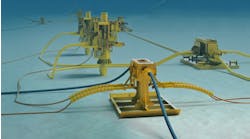Offshore staff
ABERDEEN – Shell expects to complete a plant integrity assurance project later this year on its flagship UK North Sea Brent field.
The six and a half-year program was launched in 2004, covering upgrades to the Brent Bravo, Charlie, and Delta platforms. It involved inspecting around 2,000 m (6,562 ft) of pipework, and removing and replacing a further 1,500 m (4,921 ft).
Shell applied novel plugging technology and extensive hot-tapping (cutting holes in pipes while fluids inside remained under pressure). Much of the work was performed deep inside the platforms’ concrete legs, up to 100 m (328 ft) below the sea surface.
On Brent Charlie, the Impact Project team has already completed the workscope, which comprised inspecting and assuring the integrity of the utility shaft pipework infrastructure.
Here the pipework has historically transported produced oil and water down through the platform’s three concrete legs to 16 storage cells, each 60 m (197 ft) high and 20 m (65.6 ft) diameter.
On Bravo and Delta, replacement of equivalent hydrocarbon pipework has also been completed. One problem highlighted early on in the removal stage was how to isolate the pipes at the foot of the platforms’ utility shafts to ensure no water escaped from the storage cells into the pipes (after the cells had been drained of hydrocarbons).
Since there were no valves in the pipework to isolate the system, the team developed a new type of inflatable plug – a “stapple” – to function as a barrier at the end of the pipe.
This work required specialist hot-tapping to provide entry to the system, and guiding the stapples through the pipework. Design information from the 1970s, when the platforms were built, was patchy, and the prototype stapple encountered unexpected obstacles.
Following design modifications (and extensive onshore tests of the technology to prove that the seal was totally reliable), all 32 stapples were eventually installed and inflated.
Working in the utility shafts required rope access specialists, all of whom underwent a six-month safety and competency training program onshore before heading on site. According to Shell, after 1 million manhours, there have been no lost-time incidents.
4/16/2010


